Parasites in the intestines
Verstehen, erkennen, loswerden
Dear reader,
In this article we address the topic of “ intestinal parasites in humans ” in a well-known scientific , evidence-based and profound way. The aim of the specialist article is to help you understand the subject fundamentally , recognize an infestation in yourself and to obtain the necessary knowledge, to get rid of parasites , or treat .
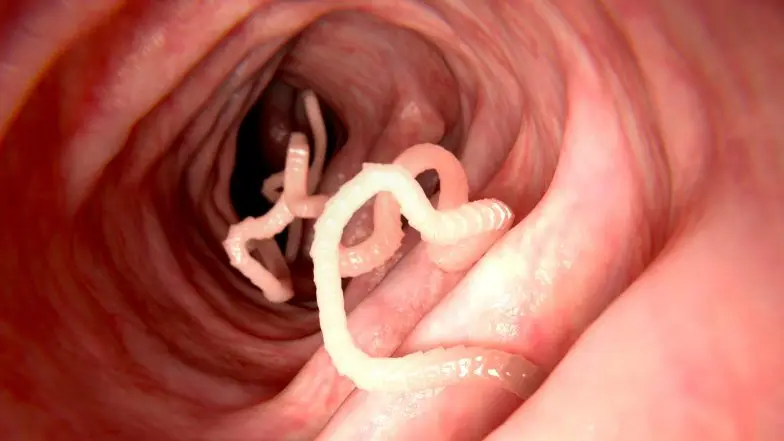
Fact check:
- Almost all people harbor parasites in their intestines , mostly without knowing it.
- A majority of the intestinal parasites are unicellular cells and not worms.
- Parasites in the intestine can trigger unspecific (not directly attributable) symptoms .
- Intestinal parasites are usually not correctly diagnosed .
by doctors
- The elimination of parasites in the intestine can go hand in hand with numerous health improvements .
- Via the intestine, parasites can also attack other organs , such as the liver or the brain .
- Infection with intestinal parasites occurs in most cases from person to person , via contaminated food or water .
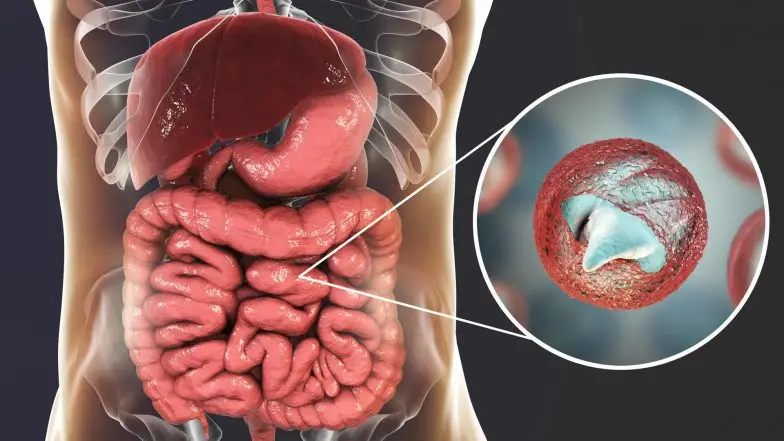
Topic overview:
- The intestine: a paradise for parasites
- Why intestinal parasites are often overlooked
- How parasites from the intestine attack other organs
- Detecting parasites in the intestine : The most common symptoms
- Health hazard Intestinal parasites: How they make people sick
- Possible parasites in the intestine
- Intestinal parasites: Avoid infection
- Get rid of parasites from the intestine
Parasites in the intestine: affects almost everyone?
The experience of our medical professionals shows that most people harbor endoparasites in their intestines . And not without reason. The intestine of the average Western European is a veritable paradise for parasites , because:
In a healthy intestine , parasites cannot thrive.
In the course of evolution, the human body has developed strategies against the invasion of parasites . Since the most common route of infection is the ingestion of parasite eggs via the digestive tract , the intestine is usually the first stop of these intruders. If the body is now able to regulate the parasitic load in the intestine , parasites can not cause the body any damage.
“good” intestinal bacteria are primarily responsible for this regulation. These have a limiting effect on the pathogenic representatives of this species [1]. For most people, however, the beneficial intestinal bacteria are in the absolute minority . In this case, parasites have easy play in the intestines.
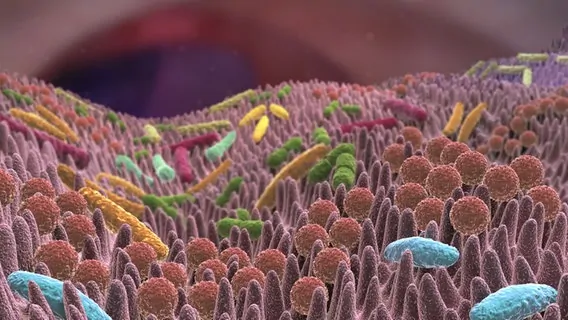
Many people are given the first antibiotics in their childhood [2]. Each dose of such a drug reduces beneficial intestinal bacteria by up to 50% [3]. Some important bacterial strains, including so-called lead strains, are even irrevocably exterminated [4].
Through antibiotic residues in meat and fish, pesticides in fruit and vegetables and above all through stress the number of beneficial intestinal bacteria increases over the course of life from [5]. The environment for parasites improves accordingly, so that an infection inevitably also leads to a parasite infestation of the intestine .

A so-called biofilm is also formed in the intestine due to the lack of bacteria. Here, parasites can protect themselves from drugs and the immune system .
Biofilm: How it makes people sick… –
An exclusive information video from the Swiss Parasite Free Association –
Look at you here the entire Parasite Academy free of charge.
The cause of the biofilm is a intestinal fault symbiosis [6]. One of the tasks of “positive” intestinal bacteria is to reduce pathogenic bacteria to a non-pathogenic level. If you are from the above Reasons are not available, “negative” bacteria spread in the intestine [7]. These form the biofilm [8].
We provide more information on biofilm in our Technical article “Biofilm in humans” to disposal.
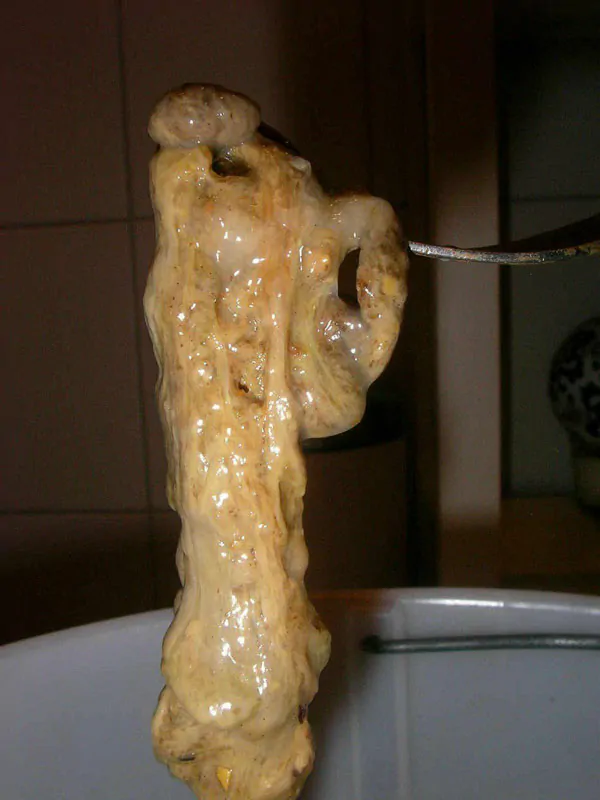
Once protected by the biofilm , parasites can hardly be removed from the intestine. To remove both, special measures are required. You can find out what these are in our large Parasite Cure Guide :
Intestinal parasites: Often overlooked, rarely diagnosed
In bowel movements , parasites are usually not to be found. The worms, unicellular organisms and flukes live in the depths of the intestine and there would be no advantage for them to be excreted with the stool. Only the eggs of the worms are occasionally placed in the stool for the purpose of spreading [9].
Why a worm infestation via the stool is only rarely diagnosed has the following background :
1. Worm eggs are not in every bowel movement ; they are only detectable in about every tenth sample [10].
2. The eggs of most genera are only detectable for a short time [11]. The stool would have to be examined immediately after elimination.
3. As a rule, not tested for unicellular parasites , which make up the main part of the parasites in the intestine . [12]
Parasites: Why Doctors Almost Never Recognize Them –
An exclusive information video from the Swiss Parasite Free Association –
Look at you here the entire Parasite Academy free of charge.
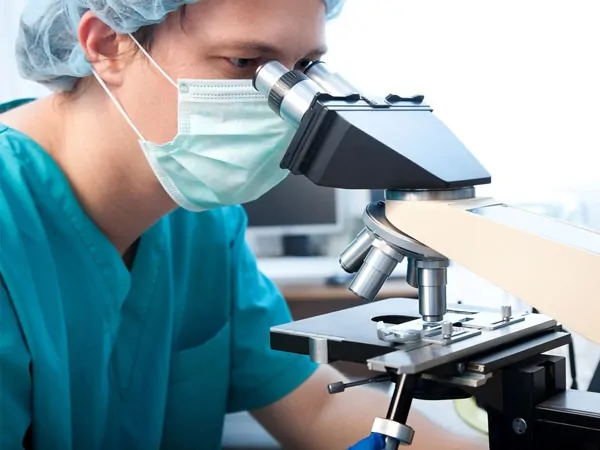
Note
Further information on why a parasite infestation is extremely seldom recognized by the doctor can be here can be obtained.
There are two exceptions where parasites are regularly found in stool:
1. In the event of an infestation with pinworms . These are small, white worms that are visible in the stool and can cause anus itch. In this case we recommend ours specific technical article on the subject of “worms in the stool: what should I do?” to consult.
Laymen in the field of parasitology assume that pinworms are the most common intestinal parasites. Due to their obviousness, however, they are only increasingly diagnosed .

2. The worms are dead . By a Parasitenkur worms in the intestine can be killed and these can then be found in the toilet. The Swiss Parasite Free Association shows what it looks like in one Image Gallery.
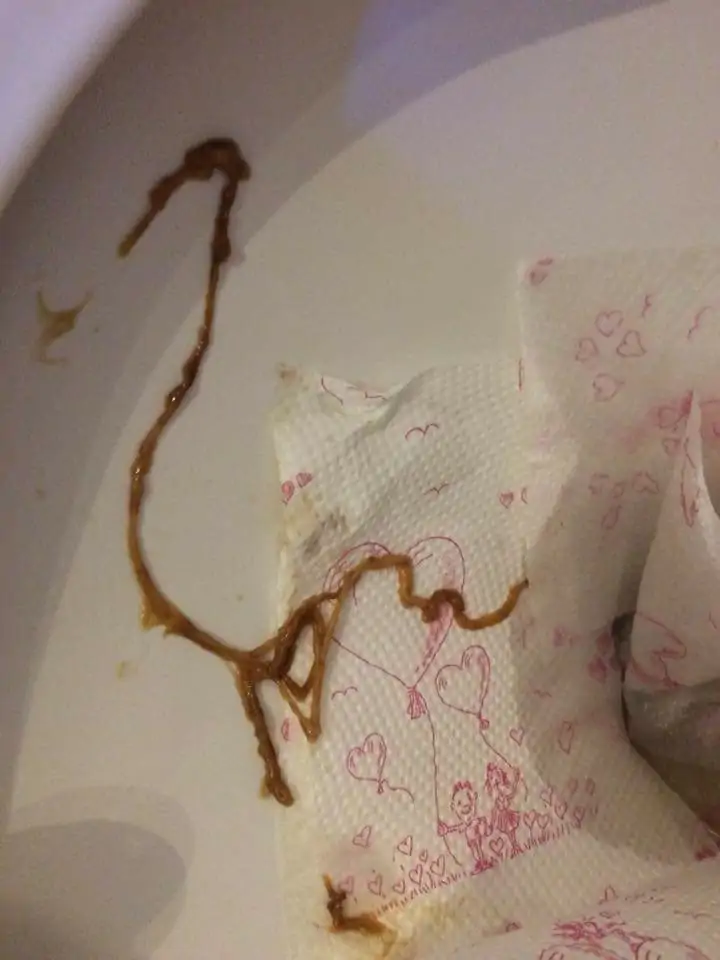
If only unspecific symptoms are present and the stool examination was negative , most doctors will find that there is no parasite infection . In this case, only specialized and trained medical professionals strive for further examinations . These could be :
- Further stool tests , at least ten times, on site in the laboratory, examined immediately after elimination
- Dark field microscopy to make parasites visible in the blood when there is already a systemic infestation
- Check the blood values for indicators of parasite infestation
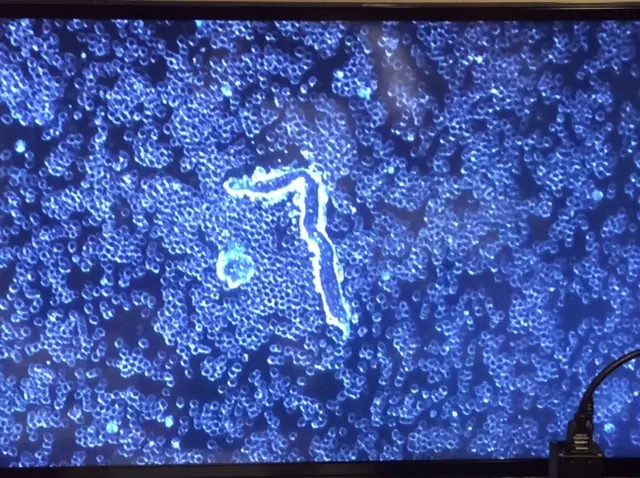
These examination methods are also not error-free and often lead to incorrect diagnoses . [13] Diagnosing parasites is a lengthy and complex process that requires specific expertise , as well as appropriate apparatus and diagnostic Tools required. [14]
Incidentally, a colonoscopy is not suitable for detecting parasites in the intestine. This is because they often live in the small intestine [15], which is not included in the colonoscopy for anatomical reasons. Parasites are biofilm not visible for the camera [16]. In addition, they are visually difficult to distinguish from the intestinal wall .
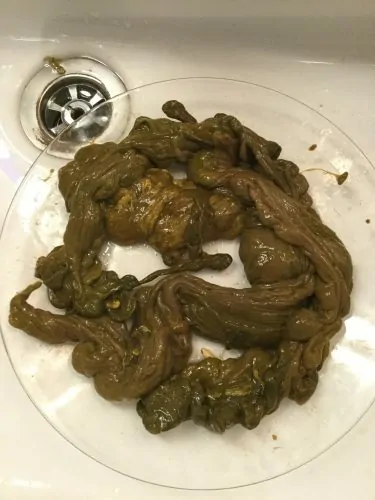
Because of the difficult diagnostic options , our doctors have developed a test which, in our experience, works exactly. Based on the presence or absence of a symptom complex , the probability of a parasite infection is reliably estimated . As part of the non-profit association work, the test is free of charge :
How parasites from the intestines infect other organs
As part of our association work, we have noticed that more and more people are suffering from systemic parasite infestation . This means that the entire organism is under parasitic load . Organs such as the heart , liver or brain can be affected. [17] Detailed information can be found in our Technical article “Parasites in the body” can be obtained.
Leaky Gut: Parasites infect all organs –
An exclusive information video from the Swiss Parasite Free Association –
Look at you here the entire Parasite Academy free of charge.
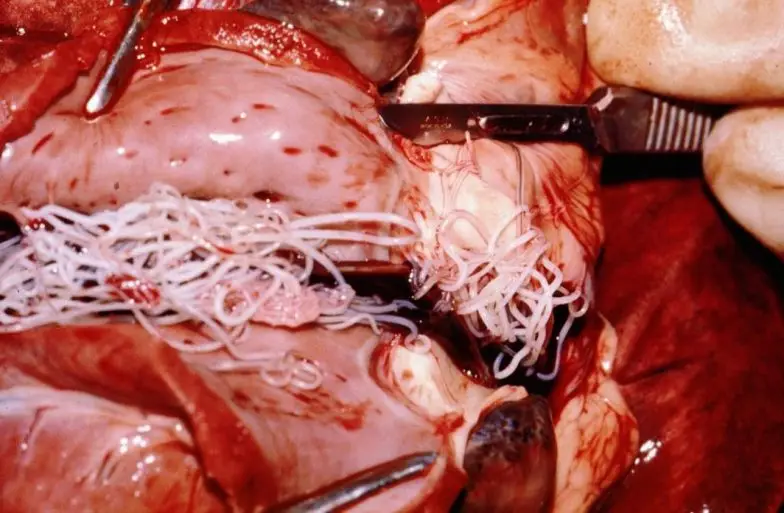
Parasite eggs get through food , contaminated water or other transfer in the intestines. A healthy intestinal wall now represents reliable protection against microbial pathogens [18], so that these can spread in the intestine but not get into the bloodstream .
In more and more people, however, the protective intestinal wall is no longer intact , but full of holes [19]. This is how microbes and parasites get from the intestines into the bloodstream and from there into all organs [20].
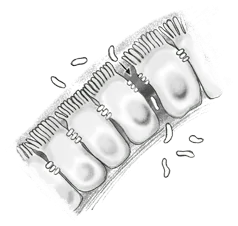
The syndrome that describes this “holey intestine” is called “ Leaky Gut ” in medicine. The causes of leaky gut syndrome are [21]:
- Malnutrition More Information
- Influence of pathogenic agents such as viruses, fungi, parasites and bacteria
- Environmental toxins
- Gut symbiosis
- Stress
- Medicines
- Consumption of alcohol
We have the symptoms of a systemic parasite infestation in Technical article: “Parasites: Symptoms in humans” described.
Parasites in the intestine: symptoms of intestinal parasite infestation in humans
As already mentioned, the complaints caused by parasites in the intestine are almost always unspecific . This means that the symptoms can not be clearly assigned to them or their effects. For this reason we recommend the free parasite test to claim, which calculates the probability of an infestation from symptom complexes.
Possible symptoms of intestinal parasites are [22].:
- Bloated stomach
- Flatulence
- Constipation or diarrhea (alternating if necessary)
- Digestive problems
- Cravings
- Fatigue
- Insomnia
- Depression
- Overweight or underweight
- Poor complexion
- Allergies
- Bad breath
- Feeling of pressure in the stomach
- Anus itch
- Visible worms in the chair
- Feeling full
- Regular abdominal pain
- Irritable Bowel Syndrome
- If necessary “Child Movements”
- Cold hands and feet
- Pallor

We have described in detail here how parasites cause these symptoms:
Health hazard intestinal parasites: How they inevitably make the host sick
Parasites in the intestine are a massive burden on health. In addition to promoting a malformed intestinal symbiosis, this is mainly due to the following reasons:
Chronic poisoning
- Through their metabolism, parasites release toxic substances into the intestine [23]. Health problems that can result from this are :
- Inflammation of the intestine, and inflammatory bowel disease, such as ulcerative colitis or Crohn’s disease [24].
- Leaky Gut Syndrome , which in turn allergies , headaches , mental illness , hair loss , autoimmune diseases , skin diseases , food intolerances and more can trigger [25].
- Inhibition of bowel movement . In a “lame intestine” fermentation and putrefaction processes occur. These toxic gases promote intestinal inflammation, leaky gut and other intestinal diseases [26].
- Immune performance and energy level are lowered . The body is busy getting rid of the toxins. This means that he has less capacity for important functions [27].
- Chronic poisoning can cause organ damage, which can trigger countless other complaints and clinical pictures [28].
- Harmful effect on the nervous system. The toxins can damage the myelin sheaths of the nerves [29]. This can lead to psychological problems (e.g. irritability), but also trigger diseases such as multiple sclerosis (MS).
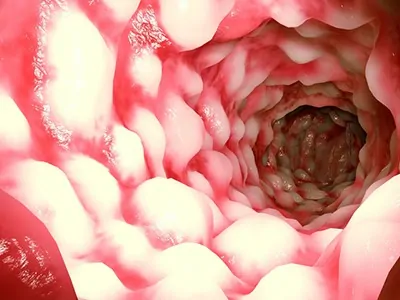
Nutrient deprivation
In the small intestine, parasites eat important nutrients , especially iron , vitamin B12 and magnesium [30]. The replenishment of vitamins, minerals and trace elements only shows short-term effects, as parasites remove them from the body again. If intestinal parasites are not treated, a deficiency can cause the following diseases in the long term [31] [32] [33]:
- Fatigue Syndrome, Chronic Fatigue
- Loss of performance
- Dementia
- Depression
- Chronic stress syndrome, burnout
- Anemia
- Nervous disorders
- chronic infections
- Coordination disorders
- Heart Disorders
- Hormone Disorders
- Osteoporosis
- Lethargy
- Metabolic diseases
- Muscle Diseases
- Circulatory disorders
- Hair loss
- Chronic headaches, migraines
- Chronic constipation
- and much more

Parasites harm humans in various other ways and can thus trigger a considerable number of different clinical pictures . More on this in our Technical article “Sick from parasites”.
The 10 most common intestinal parasites
1. Rope Worm, med. Funis Vermis
The rope worm is the most present intestinal parasite in the human body [34]. According to current studies (Volinsky & Gubarev, 2014) most people in the world harbor the highly contagious parasite [35].
We can confirm this information on the basis of the clinic. Almost every user separated rope worms as part of one Parasitenkur the end.
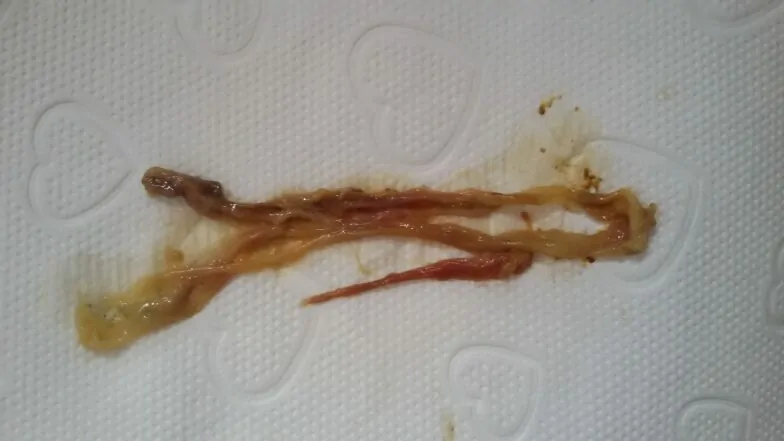
Rope Worm in the fact check [36]:
- Highly pathogenic: If triggers a variety of unspecific symptoms , it can cause massive damage to health through poisoning (produces “ toxic phlegm “) and nutrient deprivation.
- Extremely contagious : According to Russian research, almost everyone is affected.
- Not recognized by many medical professionals, but unambiguously (via DNA analysis) identified by researchers as organic and parasitic .
Scientists document health improvements both physically and mentally after the parasite has been eliminated. We can confirm this clinically. - The rope lives anaerobically , so it needs a low-oxygen environment to maintain its metabolic processes.
- Adult rope worms have an average length of 20-30 cm . The maximum length is about 100 cm.
- They primarily affect the small intestine .
- The appearance of the parasite is reminiscent of a twisted rope .
- The color of the parasite varies depending on food intake. Possible colors are white , yellowish , brown , red or rarely black .
- The parasite is not recognized as a foreign body by the immune system and can spread accordingly in the intestine.
- The rope can untwist and thereby increase its surface area drastically. In this form he is able to ingest considerable amounts of feces , from which he removes nutrients .
- The fecal stones produced by the rope worm contain eggs of the intestinal parasite.
- Cable worms are nocturnal , their metabolism is based on moon phases and the menstrual cycle of women
- The smell of the parasite is unique . It can be recognized by this, among other things.
- With suction cups, the rope worm can fix itself to the intestinal wall and suck out blood . Some excreted specimens have a visibly bloody head .
- The parasite produces large amounts of biofilm .
- A rope goes through five developmental stages , whereby the first two are slimy .
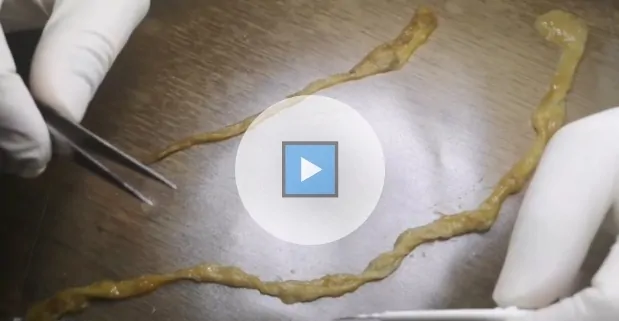
Further information can be obtained from our Technical article on rope worms can be removed.
2. Microsporidien (Mikrosporidien)
The microsporidia (or also microspora) is, as the name suggests, a single-celled fungal spore , which has a parasitic effect in the body. In the past, only people with severe immunodeficiency (e.g. AIDS) were infected. Today more and more people carry the pathogen.
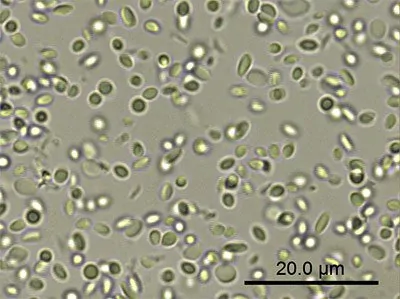
Microsporidia in the fact check [37] [38]:
- Immunocompetent people usually only have unspecific digestive problems . Indications can be persistent or recurring diarrhea and foci of inflammation in the body.
- Immunocompromised people often have severe symptoms , such as chronic diarrhea, deficiencies and inflamed organs (eyes, liver, heart, respiratory tract or muscles).
- There are 1200 species of microsporidia. at least 15 of these can affect people and cause them to become ill.
- Contagion takes place via
- Food intake
- Breathe in
- Animal contact
- Human-to-human transmission
- The parasites penetrate the cells of the host and multiply there.
All organs of the body can be attacked by the spores. - Microsporidia are a common reason for self-limiting diseases with a mild course . Therefore the infestation is often overlooked and a positive diagnosis is often only made in AIDS patients.
3. Giardia (Giardia intestinalis, Giardia lamblia)
These single-cell small intestinal parasites are also infecting more and more people and can trigger unspecific digestive symptoms .
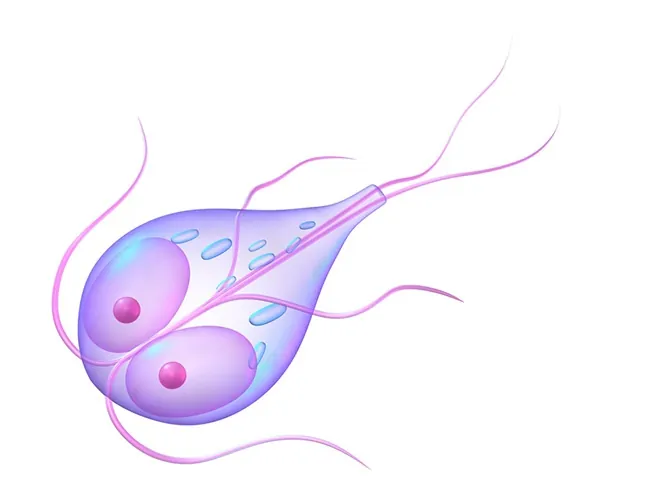
Giardia in the fact check [39]:
- Main routes of infection1: Fecal-oral
- Poor hygiene
- Eliminators (e.g. shopping cart, restaurant visit)
- In the context of sexual intercourse.
- Way of contagion 2: tap water
Giardia find their way into drinking water via liquid manure. In the waterworks they can neither be killed by ultraviolet radiation nor by chlorine treatment . - Giardia can be surrounded with a protective cover and excreted through the faeces. With the help of this, they are protected for weeks before they are accepted by a new host.
- Most infections are asymptomatic , i.e. symptom-free. Nevertheless, the bowel movement is infectious , which of course the person concerned cannot know about. Some people experience mild symptoms for a short time after being infected, such as nausea , abdominal pain and diarrhea .
- Only a long time after infection do the Giardia begin to trigger unspecific digestive symptoms . Usually these are not attributed to the microparasites .
4. Cryptosporidium (Cryptosporidium)
Optionally, the fourth most common parasites in the human intestine are cryptosporidia. In most cases, the infection is asymptomatic . mild fever , dizziness , diarrhea and abdominal cramps are rarely observed immediately after infection. These symptoms are usually not attributed to microparasites, which is why cryptosporidia are rarely diagnosed.

Cryptosporidia in the fact check [40] [41]:
- Considered in specialist circles as clearly underdiagnosed , which results from the fact that they are i. d. R. trigger no symptoms .
- In addition to the intestines, cryptosporidia can also affect the liver , the respiratory tract and the kidneys .
- Main source of infection: tap water . Chlorine cannot kill them.
The minimum number of pathogens (10 single-cell organisms) is sufficient for the infection.
5. Tapeworm (Cestoda)
This parasite in the intestine affects far more people than was recently assumed. Clear symptoms do not necessarily and also only appear years to decades after the infection.
It is generally believed that tapeworm patients are thin and emaciated. However, due to the energy dense diet in the western latitudes, this is only seldom the case.
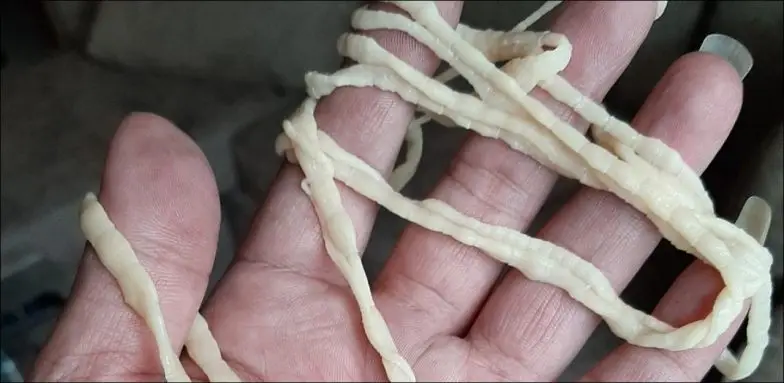
Tapeworms in the fact check [42] [43] [44]:
- Significantly more women affected than men.
- In professional circles it is assumed that over 30% of women carry this parasite.
- A tapeworm infection is often overlooked , as in most cases only unspecific symptoms are triggered:
- Cravings
- Little or no weight gain despite high-calorie food intake
- Diarrhea or constipation (alternating if necessary)
- Fatigue and poor performance
- If necessary Headache or stomach ache
- Possibly “child movements”
- Itchy anus and blood in the stool may also be possible
- The leaky gut syndrome can spread tapeworm larvae throughout the body. Infection of the muscles and other internal organs as well as the brain are possible.
- Typical tapeworms in humans are: Pork tapeworm , Beef tapeworm , Dog tapeworm and Fish tapeworm .
- Infestation with the dreaded fox tapeworm is extremely rare . Only a few people (mostly children) suffer from the dwarf tapeworm .
- Common sources of infection :
- Finnish beef and pork (mainly raw / semi-raw)
- Finniger fish (often with sushi)
- Contact with dog feces
- Oral-fecal infection (see Giardia)
- Even cooked meat does not offer complete protection .
- The tapeworm sits in the small intestine , directly under the stomach gatekeeper . There he fixes himself with suction cups and hooks on the intestinal wall .
- The entire food pulp passes through the intestinal parasites . Up to 87% of the nutrients are withheld from the host. [45]
- The tapeworm protects from digestive enzymes .
through its outer shell (neodermis).
- Depending on the type of tapeworm, the length varies from 5 millimeters (dwarf tapeworm) to 20 meters (fish tapeworm).
- Tapeworms are flat and segmented . These segments are called proglottids. In regular cycles one of them, filled with eggs , is excreted .
through the stool
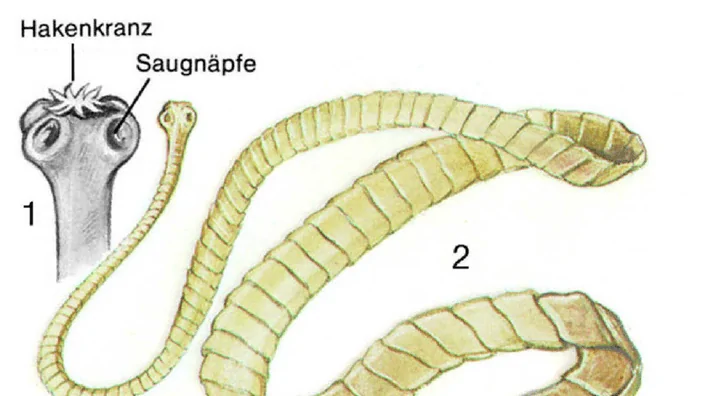
6. Roundworm (Ascariasis)
Ascariasis parasites are the third most common intestinal worms and sixth most common intestinal parasites in Western Europeans. It is reported again and again on the Internet that a roundworm infestation can even lead to death .
In fact, over 1.5 billion people in East Asia, Africa and Central America are infected with this parasite. Of these, only 0.00015% die as a result of complications from the infestation (extremely immunocompromised children in slums). For comparison: In Germany, 0.16% of all infected people die of flu. The flu is a thousand times more dangerous than the roundworm. This also makes sense from the perspective of the parasites:
Notice
Parasites do not kill their host because it is their biotope.
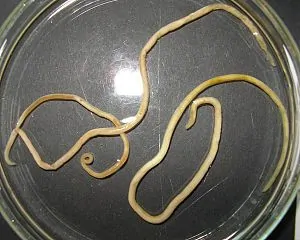
Roundworm in the fact check [46]:
- Roundworms belong to the group of roundworms (Nematoda).
- They are up to 40 cm long , are adult pencil thick and whitish, yellowish or pink .
- Ascariasis is often confused with oxyuriasis ( pinworm infestation ) .
- No direct transmission from person to person possible.
- Contaminated food is the main source of infection.
- Roundworm eggs hatch in the small intestine . The larvae pierce the intestinal wall in order to get into the bloodstream and from there into the bronchi. The parasites then reach the throat and are automatically swallowed through the esophagus. Back in the small intestine, the roundworms mature into sexually capable parasites and secrete eggs in the feces . The cycle starts again.
- The parasites can symptoms in stomach , abdomen, the bronchi and the bronchi for about 14 days after infection Trigger lung :
- Abdominal / stomach pain
- Mucous lungs
- Irritated bronchi
- Dry cough
- Sensation of pressure behind the breastbone
- If necessary slight fever
- Occasionally skin symptoms
The complaints are hardly assigned to a parasite infestation by non-specialized doctors. In addition, they are usually not so strong that a doctor is visited . For these reasons, a correct diagnosis is seldom . The symptoms subside after two weeks at the latest. The infestation remains , however. If unspecific symptoms appear months or years later, a infestation with roundworms is usually no longer considered by the doctor.
Notice
In about 30% of cases the infection is even asymptomatic .
7. Intestinal flukes (trematodes)
Schistosoma (schistosomiasis / schistosomiasis pathogen) and other intestinal leeches populate the intestines of numerous people. The leeches attach themselves to the wall of the small or large intestine and suck blood there .
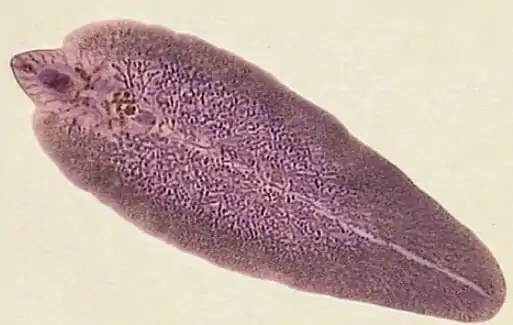
Gut leeches in the fact check [47]:
- The main source of infection is tap water . Infection through (semi) raw meat or vegetables is also possible.
- Schistosoma enter waters through water snails. People swimming in them can be infected by the parasites boring their way through the human skin .
- Most common intestinal flukes in humans: Schistosoma , Fasciolopsis buski , Heterophyes heterophyes , Metagonimus yokogawai and Echinostoma species .
- As a rule, the affected people are asymptomatic. However, intestinal leeches can cause serious complications :
- Inflammation in the bowel / inflammatory bowel disease
- Ulcerations (ulcerations). These can lead to perforation of the intestine (life-threatening).
- Symptoms can be:
- Slimy stool
- Soft chair
- Feeling unwell
- abdominal pain
- If necessary Constipation
8. Pinworms (Enterobius vermicularis)
In the feces white worms can be seen. In addition, there is usually a strong anal itching . Pinworms are sometimes classified as harmless, but this is a mistake.
Because the small worms inevitably have a pathogenic effect on the body.
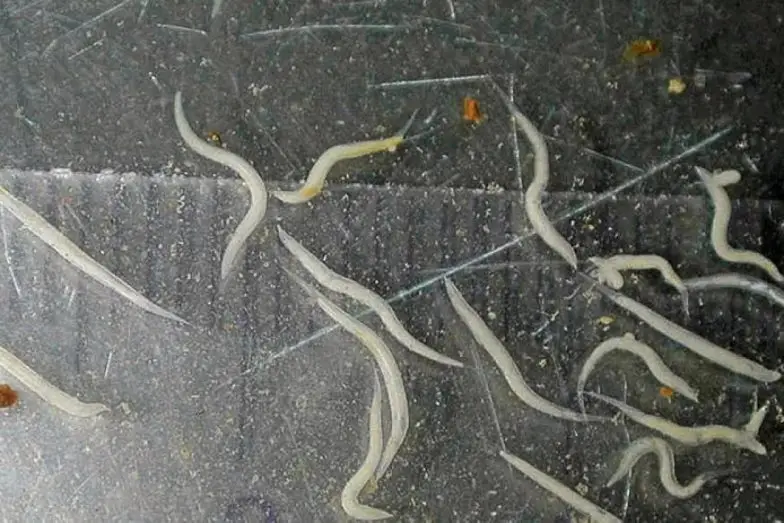
In most cases, pinworms are treated incorrectly , which often has serious consequences . Since this is of immense importance , the Swiss Parasite Free Association has devoted its own article to the topic of “pinworms”. By doing Technical article “Worms in the stool: what should I do?” explains a parasite expert:
- This is why worms are so dangerous
in humans
- The causes of a worm infestation
- Medicines against worms: dangerous and ineffective ?
- Avoid contagion
- Home remedies against pinworms
- Studies on home remedies
9. Intestinal amoeba (Entamoeba histolytica, E. dispar, E. moshkovskii)
Amoebas are mostly only known in connection with amoebic dysentery (amoebiasis), which can be triggered by these single-celled parasites. However, more severe symptoms of the disease only occur when the amoeba E. histolytica and only in 10% of the cases . With the remaining 90% or with an infection by other amoebas, the affected person is asymptomatic , but suffers from peripheral parasitic stress . This leads to unspecific complaints in the short or long term, which are hardly ever attributed to the amoeba.
Notice
Amoebas are hardly diagnosed due to the lack of symptoms
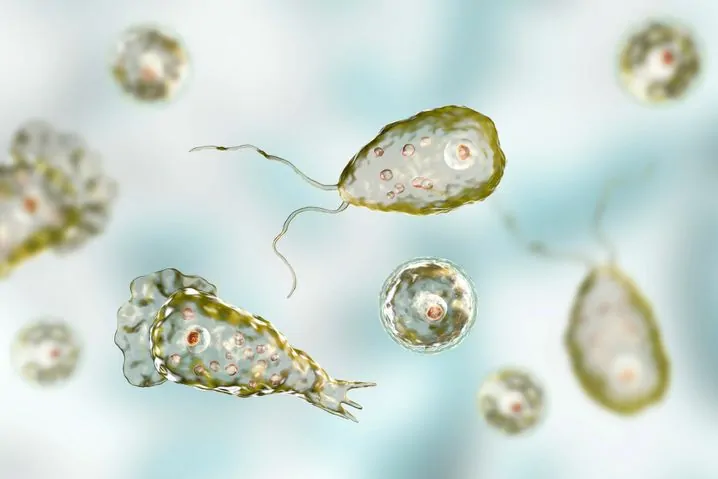
Amoebas in the fact check[48]:
- 99% of people infected with amoeba not develop amoebic dysentery.
- The main sources of infection are tap water and fecal-oral transmission .
- Contagion through (semi) raw meat or vegetables are also possible.
- Worldwide 10% of people are infected with E. histolytica alone
(The number of unreported cases is significantly higher, expert estimates speak of 40 – 60% ). - Risk of infection in tropical and subtropical countries higher than in western latitudes due to unfavorable hygiene conditions.
- In the case of leaky gut: Amoeba can infest the entire body from the intestine and cause organ damage .
- The stool is highly infectious . It is fatal that there are usually no symptoms .
- Diagnosis difficult due to lack of symptoms. Subsequent complaints from amoeba are usually not associated with them .
- Amoebic dysentery: In our experience, this only occurs with advanced intestinal malfunction . Symptoms of amoebic dysentery : The protozoa attack the intestinal wall in large populations. This leads to abdominal pain , bloody and slimy diarrhea and pus formation (abscess) in the intestine [49].
10. Blastocysts (Blastocystis hominis)
The unicellular parasite Blastocystis hominis usually does not cause any symptoms. Because of this, lay people in the field of parasitology wrongly assume that the pathogen does not cause any harm. [50].
Notice
Pure by definition every parasite causes damage in the body. He always draws one-sided benefit from living with the landlord.
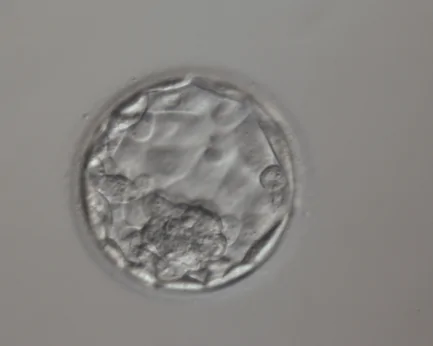
Blastocysts in the fact check [51] [52]:
- 15% of the western population are infected by the unicellular parasite.
- Spread via contaminated food , tap water and fecal-oral transmission .
- Mostly asymptomatic . If symptoms occur, then immediately after infection: Slight diarrhea , Abdominal pain , Flat stomach and possibly edema in the intestine.
- In the tropics 30% risk of infection .
Detect parasite infestation in the intestines in yourself
The classification of the most common intestinal parasites shows that it is difficult or impossible to recognize an infestation based on individual symptoms .
For this reason, the doctors of the non-profit Swiss association Parasitenfrei have had a Parasite test programmed, through which a free assessment can be obtained within a few minutes about whether an infection is present with intestinal parasites:
Parasites in the intestine are contagious: the necessary protective measures
Contagion through excretions
One goal of parasites is to spread within the body and across hosts . The latter happens primarily through the excretion of infectious eggs with the stool . The infection finally takes place in the following ways :
1.) Intestinal parasites in tap water
The number 1 source of infection is undoubtedly drinking water [53]. Parasite eggs get into the water through fertilization with liquid manure and human excretions[54]. The waterworks are financially, technically and organizationally not in a position to adequately filter the water [55]. The Drinking Water Ordinance does not define an upper limit for microbes and therefore also not for parasites [56].
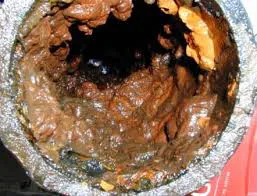
A biofilm is created in the supply pipes. Parasites from the tap water nest in this , multiply and are washed into the water again [57]. In order to prove publicly what is already known in parasite research, we examined the filter sediment of a reverse osmosis system using microscopy . We discovered living worms in the water :

The facts are described in detail in our specialist article “ Parasites – Infection through contaminated drinking water “:
2.) Contagion from person to person
The second most common source of infection are infected people [58].
Contagion can occur as follows:
– Sexual intercourse [59], above all
- anal
- fecal-oral
– Eliminators [60], e.g.:
- Visiting a restaurant (poor hygiene of the kitchen staff)
- Shopping trolleys and baskets
- Public toilets
- Handrail stairs / escalators
- Public keyboards, e.g. ATMs
- Handles and armrests in public transport

More detailed information on this can be found in our article „Parasites: Infection through shedders“ can be obtained.
3.) Contaminated vegetables
Due to increasing factory farming, the infection rate of farm animals with parasites has increased significantly in the last 20 years [61]. Farmers are already sounding the alarm. The manure from the infected animals is used to fertilize vegetable fields [62]. In addition, 21% of all Western European farms use illegal manure to cultivate their fields, which is significantly more polluted [63].

Contaminated vegetables can not be freed from parasites easily. Studies show that cleaning with water is not sufficient despite the use of a vegetable brush [64].
In our specialist article „Parasites – contaminated vegetables“ we covered this topic in detail and added videos .
4.) Parasite transmission via insects
Parasites use insects , such as B. Mosquitoes , for transmission [65]. The Arthropoda become infected with intestinal parasites through the faeces of animals [66]. Particular caution applies to ticks . Dr. Alan McDonald found out that 20 out of 30 of these bloodsuckers carry parasites [67]. Among other things, they can be the dreaded Morgellons transfer [68].
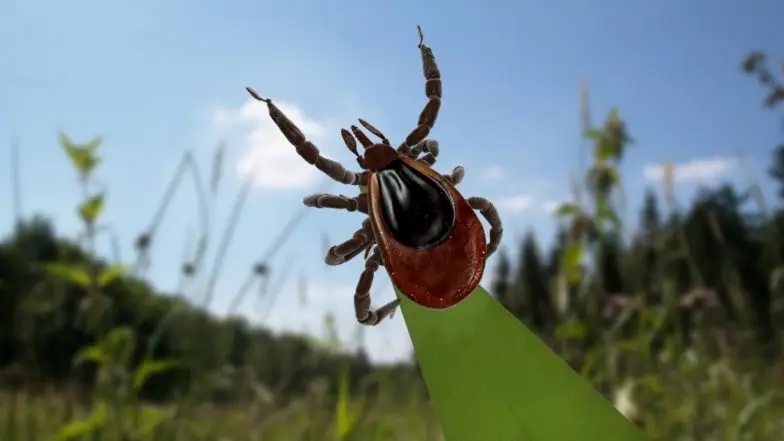
We have more on this in our specialist article „Parasitic infection via insects“ drafted.
Parasites in meat and fish
A source of infection by intestinal parasites that does not correlate with excretions is the consumption of contaminated meat or fish [69] [70]. This is because of the following reasons:
– Parasites in the meat
- Unhygienic conditions in animal husbandry (animals parasitically burdened) [71]
- Parasites are not a critical feature in meat hygiene [72]
- Heating meat is not a reliable way to kill parasites [73]
This is what everyday life looks like in large kitchens:
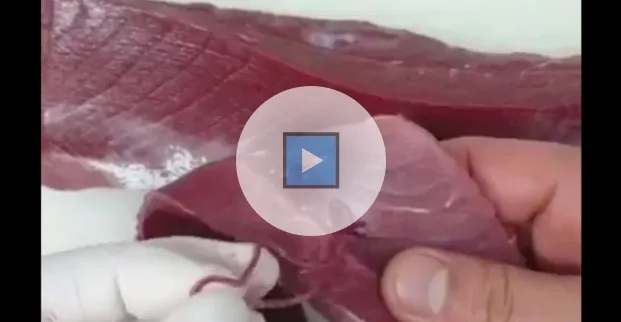
Further information and advice on infection with parasites through meat consumption are available here retrieve.
– Parasites in fish
The result is a massive infestation of food fish:

More about parasites in fish can be here can be found out.
Transmission of intestinal parasites via pets
Another way of getting infected with parasites is through dogs , cats and, more rarely, through rodents [76]. Both the oral contact with animals as well as contact with them Excretions, carries the risk of infection [77].

It is well known that dogs and cats have to be dewormed on a regular basis. Unfortunately, these measures are by no means sufficient to exclude them as carriers .
The reasons for this are:
- Only a few, specific parasite strains are killed briefly [78].
- A wormer cure is ineffective against dangerous parasites such as Toxoplasma Gondii and other unicellular species [79].
- The effectiveness of a worming cure only lasts for a short time[80].
In addition, wormer products mean serious health consequences for the animal . This and other information is the Article “Parasites – Contagion by Pets” refer to.
Note
Pinworms are an exception here. They can also be transmitted through contaminated laundry and other objects. If there is a pinworm infestation , we refer to ours Technical article “worms in the chair”.
Protective measures
We recommend the following measures to protect a transmission:
- Pets regularly or permanently deworm .
- with natural means
- Avoid tap water . Instead use pure water .
- Avoid anal practices and unprotected sexual contact with changing partners .
- Treat
- meat and fish with hydrogen peroxide or ozone before preparation. In addition, only consume well cooked .
- Wear closed clothing in the forest and in tall grass. Avoid mosquito bites , e.g. use of fly screens.
- Sterilize vegetables .
- Reduce restaurant visits . Deliberately unhygienic restaurants.
- Use Sterillium in public spaces.

Important
These measures help to avoid infection again . However, parasites that are already in the intestine and other organs must be removed or diverted . All about this in the next chapter .
Remove parasites in the intestine: get rid of worms & Co. forever
Medicines are not an effective and safe way to get rid of parasites.
The reasons for this are:
- Medicines only work specifically against a few types of parasites [81].
- Because of the serious side effects, drugs against parasites are taken only for 3 days [82]. Parasite eggs only hatch after 3 – 12 weeks (!) [83] and are until then in the Biofilm protected from anti-parasitic agents [84].
- Serious side effects, such as seizures , peeling of the skin , severe skin reactions , liver disease and much more are possible [85].
- Anti-parasite drugs can cause neutropenia [86]. This means that neutrophils are being decimated. These are essential for the defense against parasites [87]. The body’s ability to defend itself against parasites is therefore reduced .
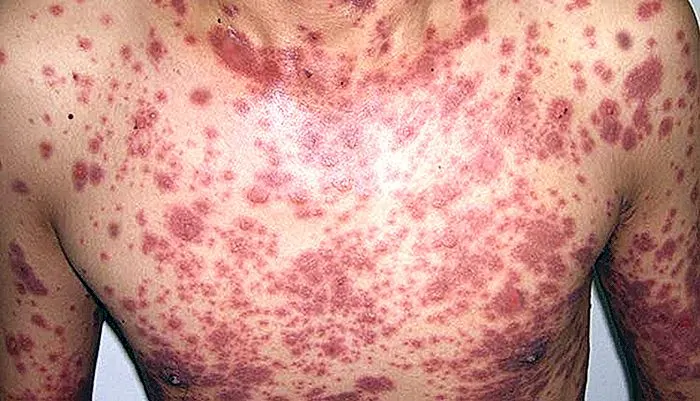
We have the topic in detail in the article „Means against parasites: medication or home remedies? “ dealt with.
Our experience
The field reports presented to us show that so far not a single user who contacted us had success with drugs in relation to parasites . On the other hand, serious side effects such as sleep disorders , massive hair loss and lasting damaged skin were reported without exception.

There is no “miracle cure” against parasites in the intestine , even if users certainly and understandably want it.
Warning
Numerous “herbal mixtures against parasites” can be found on the Internet. Unfortunately, experience has shown that these are ineffective and only divert one thing – money from your wallet . We have an independent one for the common products analysis carried out.
The “bitter” but honest pill:
Parasites are stubborn creatures that do not leave the body easily . They had 3 million years to adapt perfectly to humans . They have incredible strategies designed to survive and spread in the body.
It is therefore in good faith to think that parasites can be eliminated by taking a certain tablet or herbal mixture .

In our big one Parasitenkur-Guide We have described in detail which aspects, according to the research results, have to be considered in order to get rid of parasites in the long term .
Below are the most relevant factors from the guide in a nutshell:
- Biofilm must be diverted so that the implementation of anti-parasitic measures is sensible at all.
- Parasites get used to drugs and applications. Therefore, different phases and diversity are important.
- No Anti-parasite remedies works in isolated form against every single pathogen in the body . Consequently, the combination is crucial here. The entire spectrum of parasites must be covered by means of different effectiveness.
- Over the years parasites have Resistances against various active ingredients developed. For example, the Hulda Clark parasite cure, according to our research, obsolete.
- The length of the course must be based on the hatching cycle of the parasite eggs. We recommend a length of 6 – 12 weeks .
- A parasite cure should always be individually designed . A 20-year-old health-conscious person needs a different cure than a 40-year-old who primarily eats finished products. Nevertheless, both can be equally contaminated with parasites . The customizability is therefore crucial.
- The removal of the parasites should always be planned by an expert who can answer questions. A cure “on your own” is not only proven to be ineffective and thus thrown money , but can also cause damage to health.
- An effective parasite cure must always include all pathogenic agents . It can only take effect over the long term when the milieu of the body has harmonized and the intestine is in a symbiosis . Only then will the body be empowered to help itself in the future.
- A renewed infestation should be prevented . This requires intestinal rehabilitation , mucosal protection and the building of the immune system .
- The limiting factor in a parasite cure is always the resilience of your own body . The ingestion of large amounts of anti-parasitic agents inevitably strains him and, as experience shows, ends in interrupting the course or in organ damage . Therefore, the right time to take is of the highest relevance. Certain anti-parasitic agents are up to 220x more effective when used around the full moon . Other factors such as time of day , time of food intake or the female cycle have a major influence on the effectiveness of remedies.
- Likewise, taking into account efficient effectiveness and simultaneous protection of the body , attention must be paid to synergetic combinations of active ingredients . Synergetically combined agents are up to 2000x more effective with the same load on the body .

How an effective parasite cure is designed, which takes into account all of the listed factors , has been summarized in our large parasite cure guide :
FAQ: The most frequent questions about intestinal parasites answered briefly and concisely
Parasite expert and honorary member of the Swiss Parasite Free Association , Kira Tau , will answer the questions on the subject of “Parasites in the intestines”.
K.T .: We have a database of doctors in Switzerland, Germany, Austria, the Czech Republic and the Netherlands. Write a E-Mail an [email protected] with the result of your Parasitentests and your zip code. We will find the nearest specialist doctor for you.
The free parasite test: quick, easy, precise
K.T.: A medical history is around 450.00 euros . The parasite treatment itself starts at 700 euros . If the doctor has to see you more often, it can cost up to 2100 euros . In addition, there are costs for laboratory analysis , blood count , stool analysis and medicines . So at least 2500 euros for the entire course .
K.T.: In my experience, only one helpsParasitenkur.
K.T.: Hardly at all. A stool examination is unsuitable , the colonoscopy is also not available as a diagnostic tool (as already described). So I advise you to look at the symptom complex . der is suitable for this Free parasite test by the non-profit Swiss association Parasitenfrei.
K.T.: Only protocols should be run that have been specially designed for children . More information here.
K.T.: We have all information on this topic in one detailed technical article published .
K.T.: Here I would like you again on our Refer to specialist articles on the subject of “pinworms”.
K.T.: Here I would like you again on our Reference articles on the subject of “pinworms” .
K.T.: Yes, it may be possible. If the worms have already spread through the intestines into the bloodstream , with a little luck they can be made visible by dark field microscopy . Certain parameters in a blood test , such as decreased granulocytes, can also be an indication of parasites in the intestine.


